The Best Worst Thing
In my February newsletter I revealed my latest passion – drawing and painting on Dura-lar. The week after the newsletter published I went into the studio and noticed this:
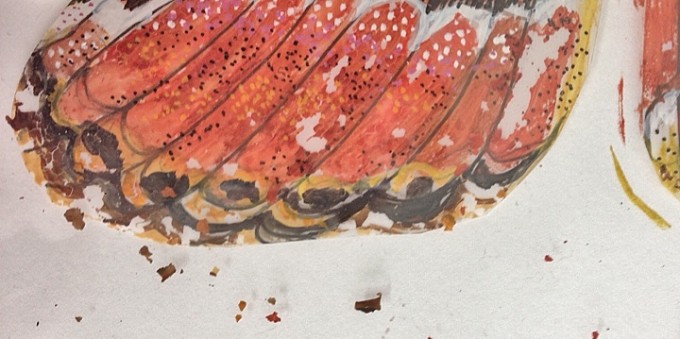
Flaking paint. F-f-f-a-a-a-h-h-h-K-K.
Epic. Material. Fail.
I can’t say I was flabbergasted that it happened. I mean, I used watercolour on a non-porous, smooth surface – I was pushing the limits of the material. I was lulled into believing I had cheated science as the paint seemed to adhere just fine as I was working on it.
[Fun Fact: flaking only seemed to be happening to one set of wings. I had covered this particular piece with a clear sheet of styrene to protect it – the rest were covered with glass. Turns out the static electricity from the plastic makes the paint jump off the Dura-lar. Fascinating to witness, but nonetheless disappointing.]
I was crestfallen. I have six butterflies on the go, almost all of the wings are watercolour on Dura-lar. It represents a total of about 70 hours of work. Work that I was going to have to re-do in more compatible media.
Not so long ago this prospect would have discouraged the hell out of me. I would have come into the studio, saw the damage, felt like everything I’d done for the past 8 weeks had been a massive waste of time and then proceeded to have a complete meltdown.
But instead of running straight out of the studio and into Netflix’s comforting arms, I gently pushed my disappointment to the side, sat down at my studio table and got to work testing new materials.
I discovered that a preliminary, micro-thin layer of acrylic gesso on the Dura-lar seems to provide enough of a porous surface for the watercolour AND still allow a bit of transparency. I wasn’t happy I had to repaint all the wings, but I was thrilled to find a solution that gave me stable results.
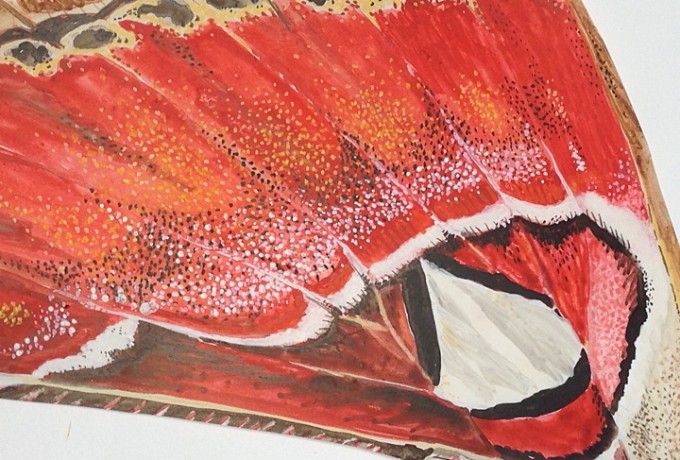
Dura-lar + Gesso test (detail).
This, however, was not the most exciting discovery. The best was yet to come.
As I was giving my watercolour on gesso on dura-lar the styrene test I decided to mess around with the non-stable wings. They were already unusable as they were, so why not? I got out my Scotch Magic Tape and started layering pieces over the painted side of the wings.
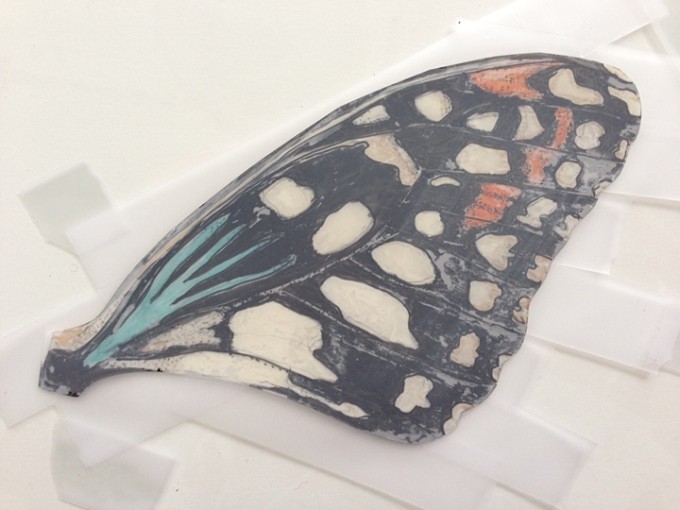
Taped wing.
My plan was to trim the tape and fold it over the edge of the Dura-lar, preventing the paint from flaking off, but when I started pulling up the rough tape edges from the sheet of glass I’d been working on I yanked a bit too hard.
I pulled the tape right off the edge of the Dura-lar and with it came the watercolour pigment. I hesitated for two seconds and then just pulled the tape, with the pigment, off the rest of the Dura-lar.
I flipped the tape wing over and added more layers of Scotch tape, sandwiching the watercolour between the sticky sides of the tape. The effect was magical. Art fucking happened.
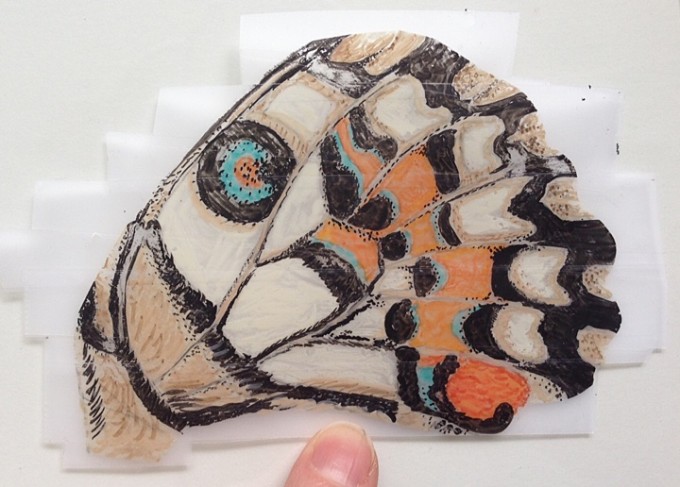
Over the next week I performed this treatment on all the watercolour wings.
The best part about the technique? Its unpredictability; sometimes the pull is very clean, resulting in a near perfect transfer…
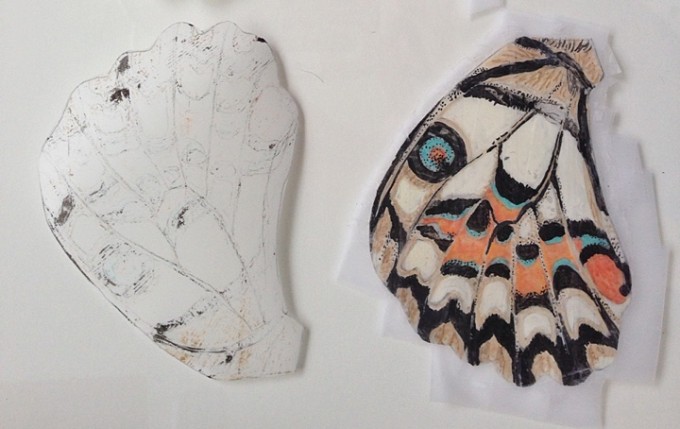
Near perfect pull.
Other times the paint pigment really sticks onto the Dura-lar, resulting in a much rougher pull…

Imperfect pull (which, coincidentally, I prefer).
Essentially, I’m pulling dry monoprints. The dormant printmaker in me is ecstatic. There are marks and textures I would never be able to achieve through any other method – it’s what I love about printmaking. I have missed these marks in my studio. Without sounding too cornball, I feel like my work has had a homecoming.
Because of a fail I had the opportunity to move my practice forward, creating with uninhibited action.
Because of a fail I discovered that the work I was making could be so much MORE of what I hoped it would be.
Because of a fail I ADORE WHAT IS HAPPENING IN MY STUDIO RIGHT NOW.
People, take your fails and do something reckless with them. Hell, take your regular work-in-progress and treat it like a fail so you’ll be open to unrestrained, productive play.
It might turn out to be the best worst thing that could happen.
Hi – I just got some dura-lar and thanks for the idea about clear gesso. I am wondering how you preserve the image once you finish – I wouldn’t think you can spray it – just wondering if you can frame it as it is. Thanks! Heather
Hi Heather, I seal the watercolor on top of gessoed Duralar with a fixative spray. I like Lascaux Fine Art Fixative. It’s quite a bit more expensive than other brands, but is conservationist quality and safe for a wide variety of media. The spray is ultra fine, so when used correctly there is no fear of displacing any pigment on your work. Good luck!
thanks for this inspiring reminder to just be in the moment and enjoy what unfolds- stunning work!
In adversity find art-portunity! Glad you didn’t succumb to that smokey Mr. Netflix again.
Love your failures! That’s a great mantra. Love our failures. Failing ‘successfully’ can be the greatest gift!
Awesome!! I just did a mixed media workshop where we did gelli prints and wow what fun! Couldn’t believe what “accidently” happened as the paint dried on the gel… when the fresh paint moistened the dry paint enough to pull of the gel onto the paper… sofaking cool